
A science institute in the United States is about to make a breakthrough in nuclear fusion research.
The National Ignition Facility (NIF) in Livermore, Calif., uses a powerful laser to heat and compress hydrogen fuel and is one step closer to achieving nuclear fusion on a large scale.
With an experiment conducted in August 2021, the lab will soon reach its goal of “ignition,” when the energy released by fusion exceeds the energy released by the laser.
Fusion is a type of nuclear power as distinct from the fission process, which has been used in nuclear power reactors since the 1950s. In fusion, energy is produced by the union of atoms, whereas in fission it is a byproduct of the splitting of atoms.
Fusion is the same process that occurs in the Sun, and requires extreme heat and pressure and is more difficult to control than fission. Once mastered, it can provide us with a source of clean and unlimited energy.
The process does not generate radioactive waste produced by fission reactors, which is one of the main barriers to the use of nuclear power today, apart from the cost and concern that arises with respect to the safety and proliferation of weapons.
Record
In a process called nuclear fusion with inertial confinement, 192 laser beams from the NIF facility – the world’s highest concentration of energy – are aimed at a peppercorn in the shape of a capsule.
This capsule contains deuterium and tritium, which are different forms of the element hydrogen.
The process compresses the fuel to 100 times the density of lead and heats it to 100 million degrees Celsius – hotter than the center of the Sun. These conditions help initiate thermonuclear fusion.
An experiment conducted on 8 August yielded 1.35 megajoules (MJ) of energy – about 70% of the laser energy reaching the fuel capsule. Achieving ignition means achieving a fusion efficiency greater than the 1.9 MJ applied by the laser.
“This is a big step forward for fusion research and for the entire community involved,” physicist Debbie Callahan of Lawrence Livermore National Laboratory, which houses the NIF, told BBC News.
This month’s experiment yielded eight times more results than the previous record (earlier this year) and 25 times more than the experiments conducted in 2018.
Jeremy Chittenden, co-director of the Center for Studies in Inertial Fusion, said, “The pace of progress in energy production has been rapid, suggesting that we may soon reach more records, such as increasing the energy of a process-initiating laser. To get across.” Imperial College in London, England.
NIF scientists also believe they have achieved something called “burning plasma,” where fusion reactions themselves heat further fusion. This is important to make the process self-sustaining and high throughput.
“We believe that our experiment has reached this stage, but we are still doing analysis and simulations so that we can understand the results,” explains Debbie Callahan.
After that re-exams will be conducted.
“This is fundamental to experimental science. We need to understand how reproducible the results are, and how sensitive they are to small changes,” Callahan says.
“Then we have plans to improve the design of this system. We will start working on it next year.”
Despite the great progress, Chittenden said there is still a lot to be done.
“The megajoules of energy released in the experiment are really impressive in terms of fusion, but in practice it is comparable to the energy needed to boil a kettle.”
“A lot of fusion energy can be gained through ignition if we can figure out how to hold the fuel together for longer periods of time, making it burn more.”
Other investments in technology
Construction of the National Ignition Facility (NIF) in the United States began in 1997 and was completed in 2009. The first experiments to test laser power began in October 2010.
Another function of the NIF is to monitor the status and security of the US nuclear weapons stockpile. Sometimes scientists who need to use giant lasers for fusion have to split their time with experiments aimed at national security.
It is one of several projects around the world focused on fusion research. One of them is the ITER facility, which has a budget of billions of euros and is currently under construction in Cadarache, France.
ITER will take a different approach for laser driven fusion at NIF; The facility in southern France will use a magnetic field to contain hot plasma—an electrically charged gas. This concept is known as magnetic confinement fusion.
But another huge leap will be required to build commercially viable fusion facilities capable of supplying grid electricity.
“Turning this concept into a renewable source of electrical energy is likely to be a lengthy process and will involve overcoming substantial technical challenges, such as revisiting this experiment several times per second to produce a stable source of energy. Being able to create,” Chittenden explains. .



